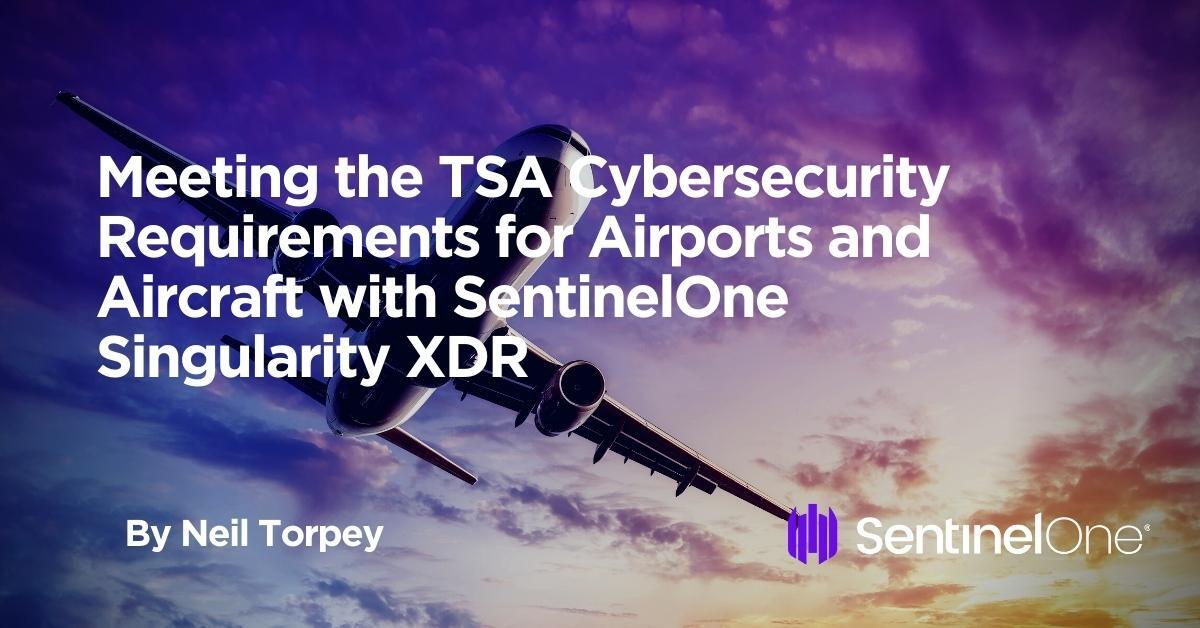The recent announcement by the Transportation Security Administration (TSA) mandating new cybersecurity requirements for airports and aircraft highlights the need for robust cybersecurity measures in the aviation industry. These requirements apply to all U.S. airports and airlines that operate commercial flights, with non-compliance resulting in penalties, legal action, and reputational damage.
This post delves deeper into the new TSA cybersecurity requirements and how SentinelOne Singularity XDR can help enterprises and federal agencies meet these requirements.

The New TSA Cybersecurity Requirements
The new cybersecurity amendment requires that impacted TSA-regulated entities develop an approved implementation plan that describes measures to improve their cybersecurity resilience and prevent disruption and degradation to their infrastructure.
The TSA cybersecurity requirements aim to strengthen the security of aviation systems and protect against cyber threats. The requirements include:
- Stronger access controls
- Regular vulnerability assessments
- Incident response plans
- Adoption of cybersecurity best practices, such as encryption and multi-factor authentication
- Micro-segmentation to reduce the attack surface
The emergency amendment mandates the following actions for impacted TSA-regulated entities:
- Develop network segmentation policies and controls to ensure that operational technology systems can continue to operate safely in the event that an information technology system has been compromised, and vice versa
- Create access control measures to secure and prevent unauthorized access to critical cyber systems
- Implement continuous monitoring and detection policies and procedures to defend against, detect, and respond to cybersecurity threats and anomalies that affect critical cyber system operations
- Reduce the risk of exploitation of unpatched systems through the application of security patches and updates for operating systems, applications, drivers, and firmware on critical cyber systems in a timely manner using a risk-based methodology
The new requirements highlight the need for a comprehensive and proactive cybersecurity approach. By leveraging solutions such as SentinelOne Singularity XDR, enterprises in the aviation industry can improve their security posture, meet the new TSA cybersecurity requirements, and ensure compliance.
SentinelOne Singularity XDR for Meeting the TSA Cybersecurity Requirements
SentinelOne Singularity XDR is a comprehensive solution that can help enterprises in the aviation industry improve their security posture, meet the new TSA cybersecurity requirements, and ensure compliance.
The following are the key functionalities of SentinelOne Singularity XDR and their business outcomes that can help enterprises meet these requirements:
Scalability and Manageability
SentinelOne’s firewall control solution is highly scalable and easy to manage. It has a central management architecture that simplifies policy management and ensures consistency, making it easier to meet the TSA’s requirements. Unlike Microsoft solutions, which can be difficult to manage, SentinelOne supports cross-OS management, enabling enterprises to manage micro-segmentation policies dynamically across multiple operating systems, including Windows, macOS, and Linux.
Business Outcomes:
- Reduced operational overheads
- Improved security posture
- Simplified policy management
Easy-to-Implement Micro-Segmentation
Micro-segmentation is critical to reducing the attack surface in enterprise environments.
SentinelOne Singularity XDR provides easy-to-implement micro-segmentation, which improves visibility and strengthens overall security posture.
Business Outcomes:
- Reduced attack surface
- Improved visibility
- Strengthened overall security posture
Dynamic Policy Assignment Based on Endpoint Tags and Location Awareness
Dynamic policy assignment based on endpoint tags and location awareness is essential to managing micro-segmentation effectively. SentinelOne Singularity XDR enables enterprises to dynamically and automatically determine what firewall policies to assign to specific machines based on location, simplifying policy management and enhancing security.
The tagging of policy assignments across different scopes and the ability to assign policies per application instead of per machine makes SentinelOne Singularity XDR a highly scalable solution.
Business Outcomes:
- Improved efficacy of security policies
- Reduced time spent managing endpoint policies
- Enhanced security posture
Advanced Multi-Tenancy and Inherited Policies
SentinelOne Singularity XDR’s advanced multi-tenancy provides a centralized console for managing security policies, alerts, and incidents for multiple customers, making it ideal for enterprises with multiple sub-agencies, such as federal agencies. Additionally, SentinelOne Singularity XDR supports inherited policies, which are dynamically assigned per application, making it easier to manage policies across large-scale environments.
Business Outcomes:
- Streamlined security operations
- Simplified policy management
- Reduced operational overheads
Conclusion
The TSA cybersecurity requirements mandate robust cybersecurity measures to protect against cyber threats in the aviation industry. SentinelOne Singularity XDR can help enterprises meet these requirements by providing advanced multi-tenancy, dynamic policy assignments based on endpoint tags, and easy-to-implement micro-segmentation.
By leveraging these functionalities, enterprises can improve their security posture, reduce the risk of cyber attacks, and ensure compliance with the new TSA cybersecurity requirements.
To learn more about how SentinelOne https://www.sentinelone.com/platform/singularity-xdrSingularity XDR can help your enterprise meet compliance, contact us or request a demo.


